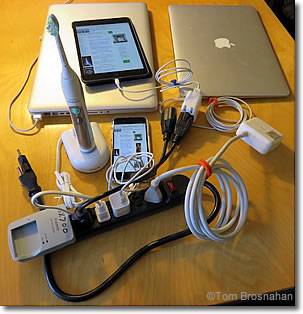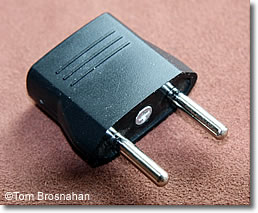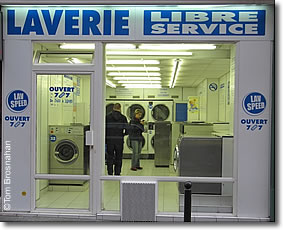 |
Electrical Power Strip in France | |
| If you travel as we do, you have multiple electronic devices to charge daily. You need adapters to handle all of your electrical devices. | ||
|
|
|
If you're like most travelers on a trip to France, you've got several electronic devices to charge each day. A budget or old-fashioned French hotel room may have only one electrical outlet, and that in an inconvenient place. Usually there are more outlets than one, even if some are behind the bed. But wait...you've got several electronic devices to charge! When Jane and I travel in France to update ParisTravelPlanner.com and FranceTravelPlanner.com, we need to charge all of the following devices:
That's around a dozen devices in all; but we normally don't need to charge them all at once. We've bought and used all the devices described below and we've found them good, which is why we recommend them to you. If you purchase devices via a link from this page, we may receive a small (and I mean SMALL) commission from Amazon.com. It doesn't raise the price you pay (it just lowers Amazon's take a fraction), and this small commission helps to support all the information we provide to you for free on FranceTravelPlanner.com. Thank you! 1. Multi-Outlet AdaptersThese adapters are rated for 100V to 250V, 1875W (15A max) which means they can be used with either North American (NA) or European electricity. They come with either a European- or North American-style plug, and three or four NA outlets plus two or three 5-Volt, 2.4-Amp USB outlets (total USB output: 12 Watts). (Don't see the image? Click here!) An alternative is a pwoer cube with a NA plug. Use it as-is for North American travel, and with a Euro-adapter for travel in Europe. 2. Outlet ExtenderPlug this outlet extender into one of your multi-outlet adapter outlets and you have four more two-prong NA outlets—and you don't even lose the three-prong outlet you plugged into, because the extender has a three-prong as well: (Don't see the image? Click here!) Thus, one multi-outlet adapter and one outlet extender give you seven or eight NA outlets plus two or three USB outlets: up to eleven outlets in all. Motion-Sensitive NightlightsAbout those motion-sensitive nightlights: we prefer to sleep in a dark hotel bedroom, but what about that midnight trip to the bathroom? We discovered these rechargeable motion-sensitive nightlights, and they're just what we need: we set them up at convenient places along the way, they come on when we need them, then go off. Brightness is adjustable. More... (Don't see the image? Click here!) Power Cord SplitterA power cord splitter (or power splitter cord) is an electrical wire with a North American plug at one end and two or more North American sockets on separate wires at the other end. Plug the splitter into an adapter in a French outlet, and you've got several independent sockets in which to plug your numerous electrical devices. A splitter is particularly useful if your devices have extra-large plugs or transformers: there's plenty of room on each independent socket. (This is an advantage over a power strip—see below). Plug a second splitter cord into one of the sockets and you can have up to seven sockets available; or use the two splitters in different locations in your hotel room or apartment. The problem with these cords is that they're heavy! The small cube adapters are more weight-efficient. What's a Power Strip?A power strip (or power tap) is a device providing multiple sockets/outlets (usually 6 or 8) connected to a cord with a plug on the end. Several devices can be plugged into the power strip. When the plug on the cord is plugged into an electrical outlet, all of the sockets receive electrical current. In effect, a power strip turns one socket/outlet into 6 or 8 sockets—which is what travelers need these days. With a power strip, you only need one plug adapter: for the plug on the power strip. All of your home-country devices are then plugged into the power strip.
Not a Surge Suppressor!But here's the challenge: most power taps sold in North America and some other countries these days are also surge suppressors, meaning that they contain electronic circuitry to detect and stop electrical power surges that could damage your electronic equipment. If this electronic circuitry is designed to operate on North American-standard 120-140-volt 60-Hertz electric current, and you plug such a surge suppressor into a French outlet which provides 220-240-volt, 50-Hertz current, the surge suppressor will burn out, or even explode! We learned this the hard way. The explosion wasn't all that dramatic, but it ruined the surge suppressor, and so we didn't have the use of it for the rest of our trip. It was junk. We threw it away. Hardware and electronics stores in North American usually display many more surge supressors than simple power taps, so shop carefully. Look on the unit itself. If you see the term surge supressor or surge protector on it, do not use it in France unless it is suitable for 220-240-volt, 50-Hertz current.
What you want to take when you travel in France is a simple power strip with no surge suppressor circuitry in it. A simple power strip merely connects several plugs to one socket. It contains no electronic circuitry to detect or suppress surges, but in my experience power surges are not a big problem in France. You'll need a plug adapter to connect your power tap charging station to the French outlet. Here's what you'll need. Next: Wifi & Laundry!Your next question is probably: what about Wifi? How do I connect to the Internet while traveling in France? And...what about washing laundry (and not paying outrageous hotel-laundry prices)? There are lots more answers in the 2000+ pages of ParisTravelPlanner.com and FranceTravelPlanner.com.
|
|
Above, a Tom-and-Jane charging station:
|












